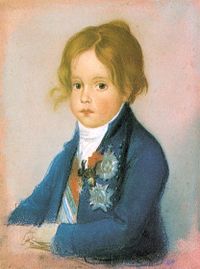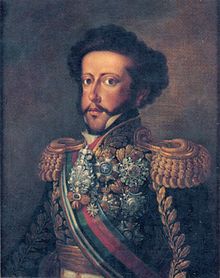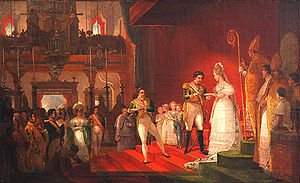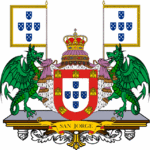- Pedro I of Brazil
-
Pedro I of Brazil
Pedro IV of Portugal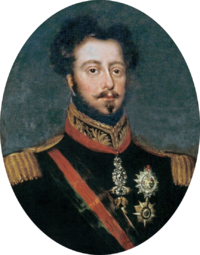
Emperor Dom Pedro I around age 35, c. 1834 Emperor of Brazil Reign 12 October 1822 – 7 April 1831 Coronation 1 December 1822 Successor Pedro II King of Portugal and the Algarves Reign 10 March 1826 – 28 May 1826 Predecessor John VI Successor Maria II Spouse Maria Leopoldina of Austria
Amélia of LeuchtenbergIssue Maria II of Portugal
Januária Maria, Princess Imperial of Brazil
Princess Francisca
Pedro II of Brazil
Princess Maria AméliaFull name Pedro de Alcântara Francisco António João Carlos Xavier de Paula Miguel Rafael Joaquim José Gonzaga Pascoal Cipriano Serafim House House of Braganza Father John VI of Portugal Mother Carlota Joaquina de Bourbon Born 12 October 1798
Queluz Palace, LisbonDied 24 September 1834 (aged 35)
Queluz Palace, LisbonBurial Museu Paulista, São Paulo Religion Roman Catholicism Pedro I of Brazil (Portuguese pronunciation: [ˈpedɾu]; English: Peter I, 12 October 1798 – 24 September 1834), was the founder and first ruler of the Empire of Brazil and also King of Portugal as Pedro IV, having reigned for eight years in Brazil and two months in Portugal.
Contents
Early years
Birth
Pedro was born around 8:02 a.m. on 12 October 1798 at the Queluz National Palace, near Lisbon, Portugal.[1][2][3][4] Named after St. Peter of Alcantara,[5] his name in full was Pedro de Alcântara Francisco António João Carlos Xavier de Paula Miguel Rafael Joaquim José Gonzaga Pascoal Cipriano Serafim.[6] He was referred to using the honorific "Dom" (Lord) from birth.[7]
Through his father, Prince Regent João (later King João VI), he was a member of the House of Braganza[8][9] and a grandson of King Pedro III and Queen Maria I of Portugal, who were uncle and niece as well as husband and wife.[10][11] His mother, Carlota Joaquina, was the daughter of King Carlos IV of Spain.[12]
The second eldest son, Pedro became the heir to his father as Prince of Beira upon the death of his elder brother António in 1801.[4] João had been acting as regent on behalf of his mother, Queen Maria I, since 1792 when she became incurably insane.[13][14] By 1802 Pedro's parents were separated, with João living in the Mafra National Palace and Carlota Joaquina in the Palace of Ramalhão.[15][16] Pedro, as well as his siblings, lived far away from his father and mother and resided in the Queluz Palace, along with his grandmother Maria I.[15][16] The young prince only saw João and Carlota Joaquina during affairs of state that occurred in Queluz.[15]
Tradition in the Portuguese Royal House demanded that Pedro was to be cared for by an aia (governess), who would be in charge of the prince's personal establishment (or chamber), composed of several servants.[17] Of the women chosen for the post, the most important was the last, Dona Maria Genoveva do Rêgo e Matos, whom Pedro regarded as his surrogate mother.[18] She "was subject to his tantrums, but she received and returned his love."[18] At age 7, Pedro was to be placed under the charge of an aio (supervisor), who "would guide his upbringing and oversee his education".[19]
Education
In late November 1807, when Pedro was nine, the royal family left Portugal as an invading French army approached Lisbon (see Peninsular War).[20] They arrived in Brazil with an English escort in early 1808. The family would remain in the country for 13 years. Their presence made Rio de Janeiro the de facto capital of the Portuguese Empire, and led to Brazil's elevation to the status of a kingdom equal with Portugal.
It is said that Pedro was John VI's favorite son, although the same could not be said about Carlota, who cherished her second son Miguel. Pedro's education was neglected, and both he and his brother Miguel were brought up haphazardly.[21] Pedro and Miguel would often run away from their tutors to mingle with stable boys and spent their days running around the streets with uneducated children.[21] As a result, the boys picked up habits and colloquialisms that were considered uncouth by some of their contemporaries, and Pedro grew up with little respect for the symbols and conventions of his age.[22] In the words of one his biographers, "He felt himself to be a son of the people rather than of royalty, and all his life long he was to be on cordial and familiar terms with individuals of every walk in life."[22]
Pedro adapted well to the Brazilian milieu. He was an excellent horseman, enjoyed the military life, and could compete with common soldiers and officers equally. Also, he demonstrated early musical talents and later composed some music of creditable quality.[23] Besides music, he displayed a knack for drawing, sculpture, poetry, and handicrafts, such as wood carving.[24] He was considered to be handsome, and soon developed a reputation as a womanizer. Riding on horseback, he would often be bold enough to draw back the curtains of passing coaches, in the hope of finding a beautiful woman.[25] His young endeavors with these women would give him a bad reputation that he would not be able to shed in the future.
On 13 May 1817, Pedro married by proxy Archduchess Maria Leopoldina, a daughter of Emperor Francis I of Austria.[26] Although she married him for dynastic reasons, she loved her husband even if it was not reciprocal.[27] Throughout Pedro's difficulties, she proved to be a devoted collaborator. Leopoldina's intelligence, consideration, and personality quickly earned her the respect and admiration of the Portuguese and Brazilians, as well as of her husband, but she was unable to distract him from his amorous affairs. Leopoldina lacked many of the feminine traits which appealed to Pedro.[27] She was modest in her appearance and had little interest in personal adornment.[27] As she began to get to know the Brazilians better and understand their noble qualities of freedom and independence, she started to love the Brazilians and considered herself as being one.
Brazilian independence
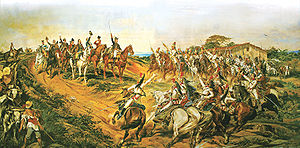 Independence or death: oil on canvas by Pedro Américo (1888)
Independence or death: oil on canvas by Pedro Américo (1888)
John VI returned to Lisbon in late April 1821 after the defeat of Napoleon, leaving his 22-year-old son Prince Pedro as regent in Rio. He did not leave empty handed, however; he took from Rio de Janeiro to Portugal 50 million cruzados.[28] Most of the privileges that had been accorded to Brazil during the royal family's absence from Europe were rescinded, sparking the ire of local nationalists.[29] Inspired by the newly-won independence of Spain's former South American colonies, Brazilian patriotism and nationalist sentiment grew, and Pedro sided with the nationalist element. Before his departure for Portugal, John VI had presciently advised Pedro to declare Brazil independent and take the throne for himself in the event of revolt rather than allow a usurper to take over the country.[30] This way there would still be a Portuguese king in power in Brazil. The Brazilian elite were scared of recolonization, the loss of control over the provinces, and potential revolution in the event of the regent's departure.[31] When pressed by the Portuguese Cortes to return to Europe, Pedro refused.[32] His official declaration of permanence on 9 January 1822 is known today in Brazil as the Dia do Fico (I Will Remain Day). For that, he was demoted from regent to a mere representative of the Lisbon court in Brazil. This news reached him on 7 September 1822, when he had just arrived in São Paulo, from a visit to the port of Santos. On the banks of the Ipiranga River, he unsheathed his sword, removed the blue and white Portuguese shield from his coat, and declared "Independence or death!"[33] This later became his famous speech O grito do Ipiranga (The Cry of Ipiranga). By the year's end, Pedro had officially declared Brazil an independent constitutional monarchy with himself as monarch. He was proclaimed Emperor of Brazil on 12 October 1822, his 24th birthday, and was crowned on 1 December.[34]
Reign in Brazil
The early years of Brazilian independence were difficult. Dom Pedro I assumed the title of emperor instead of king to underline the diversity of the Brazilian provinces. The Napoleonic concept of Empire as a more modern and progressive form of monarchy embodying rejection of the Ancien Régime was also useful in uniting the relatively cosmopolitan society of Rio de Janeiro with the more conservative, patriarchal stance held in the rest of the country.
In early 1823, the first problem confronting Pedro I was drafting a constitution. Brazil was divided between the Brazilian Party led by José Bonifácio, which included the landed aristocracy who favored a constitutional monarchy, and the Portuguese party which included the commercial class, office holders and families of recent Portuguese origin, who wanted an absolutist monarchy. In 1822, during the struggle for independence, Pedro I had considered himself a liberal and had promised Brazil a constitution. He soon appeared to forget his liberal ideals by enacting a Constitution that gave him substantial power. This was seen as necessary to keep control of the interior, particularly in the feudal North, and to prevent the instability and democratic fractioning that characterized other areas of Latin America during this time. The Brazilian party dominated the assembly and refused to assent to so much power in the hands of the emperor. Conflict increased further after Muniz Tavares, a Brazilian assemblyman, attacked the Portuguese party, which he believed resented Brazilian independence. The Sentinella and the Tamoyo, two constitutionalist papers, were written to attack Portuguese born officials. In response to the dispute, Pedro dissolved the assembly on 11 November 1823.[35] He exiled many assemblymen, including José Bonifácio, and jailed a few.[36] Upholding his promise to provide a constitution, he then gathered a committee of ten who then ratified a new, but very similar, constitution on 25 March 1824. This rewritten constitution remained in effect until the end of the Brazilian empire in 1889.[37]
The new constitution established a conservative, centralized monarchy with significant constitutional limitations and power-sharing. It sought to maintain stability and protect property. Powers were divided into executive, legislative, judiciary, and moderating branches. The legislative branch contained the Senate and the Chamber of Deputies, both of whose members were elected to power. Unlike the Chamber of Deputies, the Senate remained in office for life. The Council of State, or the judicial branch, consisted of a council of respected elders whom the emperor appointed for life and who exercised executive powers to issue judgments in important issues, such as war. The emperor held supremacy or moderating power. He could therefore veto all resolutions. He was also empowered to appoint a senator from a group of elected senators, appoint councils of state, pardon criminals, review judicial decisions, and replace elected deputies, presidents of provinces, ministers, bishops and senators. Pedro's failure to put the constitution in effect immediately, however, left many Brazilians suspicious that Pedro's support of a constitution was a ruse.
During 1824 and 1825, many Brazilians became opposed to the accumulated powers of the emperor and the unpopular provincial presidents he appointed. Secret opposition papers attacked the emperor, his ministers, his servants and his mistresses, in particular Domitila de Castro, Marchioness of Santos. Dissatisfaction climaxed with the revolt of liberal urban forces in Pernambuco. Friar Joaquim do Amor Divino (popularly known as "Frei Caneca") led a revolt in response to the appointment of an unpopular governor, Francisco Paes Barreto. In July 1824, Frei Caneca and Manuel de Carvalho sought to unite several republics in the formation of the Confederation of the Equator. The Confederation failed to take hold and the emperor put many revolutionaries to death, including Frei Caneca.
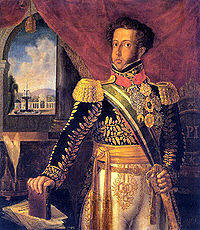 Portrait by Manuel de Araújo Porto-alegre
Portrait by Manuel de Araújo Porto-alegre
The absolutist character of events in Rio raised concern in the mostly liberal Northeast. This region soon called for its own constituent assembly. But the movement was not a success because it was divided within itself on the issue of slavery and because Pedro hired British and French ships and mercenaries to repress them. Consequently, Britain underwrote much of the transition to Brazilian independence. Britain could also facilitate recognition from the international community, and Pedro sought this recognition of Brazil's independence. At first European nations were reluctant because of the hesitance of Portugal. The United States became the first to recognize its independence. By 1825 Britain, realizing the importance of Brazil's market, convinced Portugal to accept Brazil's independence. In exchange, Pedro agreed to repay a loan from Britain for the war between Portugal and Brazil. The loan implied that Pedro would inherit the Portuguese throne. He also signed a treaty with Britain, continuing the 15% import tariff and abolishing the slave trade within three years. The concessions to end slavery especially made Pedro I unpopular with the landed aristocracy, which constituted much of the Brazilian party.
Republican sentiment soared, and during the 1825 Cisplatine War with Argentina, the Cisplatine province seceded to become Uruguay. The war lasted for two years, and as a result Brazil suffered great military and financial devastation. While Pedro was visiting the troops in November and December 1826, Empress Leopoldina died after a miscarriage.[38] Rumors spread that she had been poisoned by the Emperor's mistress, Domitila.[39] Pamphlets were published accusing Pedro of imposing physical violence on her during her pregnancy, while having an affair with Domitila. Pedro resolved to marry again, and asked his father-in-law (Emporer Francis of Austria) for help in securing a bride.[40] Gossip about Pedro's infidelity and the circumstances of Leopoldina's death damaged his reputation and Brazilian diplomats searching for a second wife were met with a round of refusals.[41] Pedro and his officials discovered that the Austrian chancellor Klemens von Metternich actively worked to prevent any match as part of a policy to contain Pedro.[42] In August 1829, Pedro agreed a marriage contract with a traditionally anti- Metternich family: the House of Beauharnais.[43] On 17 October 1829, Pedro married his second wife, Princess Amélie of Leuchtenberg, in Rio de Janeiro. Amélie was the daughter of Eugène de Beauharnais, Duke of Leuchtenberg, and the granddaughter of the Empress Josephine.
Domestically, Pedro was accused of mismanaging financial affairs. During his reign, debt rose, inflation grew, the exchange rate sank, and the bank issued ineffective paper money which drove gold and silver out of circulation. The cost of living rose in the cities. British tariffs also troubled the elite and middle class, who demanded imported consumer goods. The production of tobacco, leather, cocoa, cotton, and even coffee declined. With the Portuguese still in control of most of the retail market, anti-Portuguese feelings mounted. The cumulative result of military, domestic and economic setbacks prompted most of the urban elite, who had been absolutists, to side with the liberals. Even the army, discontented with Portuguese commanders and military defeats, distanced itself from the emperor.
In the end, Dom Pedro's aspirations in Portugal cost him his rule in Brazil.
Portuguese succession
On the death of his father, João VI, on 10 March 1826 Pedro briefly inherited his title as King of Portugal as Pedro IV. He promulgated, from Rio de Janeiro, a new Portuguese liberal constitution in late April. This Constitution confirmed the exclusion of Pedro's Brazilian heir, the Prince Imperial, from the Portuguese succession, by establishing that the Portuguese crown would be inherited by Pedro's eldest daughter, Princess Maria da Glória. The language of the Constitutional Charter, in speaking of a "cession of right", already announced the abdication that was to come. On 28 May 1826, Pedro abdicated the Portuguese throne in favor of his seven year old daughter, who became Queen Maria II of Portugal. However there was a key condition, that, when she became of age (14 years), she would marry Pedro's brother Miguel. Pedro's sister, Infanta Isabel Maria of Portugal, became regent. Miguel accepted this solution and distanced himself from the absolutists, some of whom staged a rebellion, failed, and fled to Spain.
In 1827, Miguel attempted to put a claim on the regency over Isabel Maria, although nobody accepted the suggestion out of fear of the absolutists. On 22 February 1828, Miguel returned to Portugal, and four days later he took the oath to his brother and the charter and was installed as lieutenant-general. This loyalty did not last long. Miguel and his mother, Carlota Joaquina, immediately began to oust the liberals and demonstrations in favor of Pedro or the constitution were prohibited.
A group of exiled liberals landed at Porto from the British ship, the Belfast, and raised a rebellion. The rebellion failed and the senior liberals were forced to take refuge back on the Belfast, and leave again for England. Of all of Portuguese territory, only the Azores remained faithful to Pedro, partly because the garrison stayed loyal. On 11 July 1828, Miguel was proclaimed king. The United States, Spain, Russia and the Holy See recognized him as king.[44] Great Britain and France protested against the illegal suppression of the constitution. In August 1829, Miguel sent a squadron of 22 ships to the Azores, which were controlled by Pedro. After a day of battle, the liberals under the Count of Vila Flor emerged victorious, taking hundreds of prisoners.
In the aftermath of a political crisis that followed the dismissal of his ministers,[45] and amid a growing economic crisis, Pedro abdicated his throne in Brazil on 7 April 1831 in favor of his son Pedro II, who was only five at the time. José Bonifácio, who had returned from exile only months before, was appointed guardian of the new emperor and his siblings.[46] Pedro I assumed the title "Duke of Braganza",[47] and sailed for Europe. In Britain and France he began to organize a military expedition against his brother Miguel.[44]
War and death
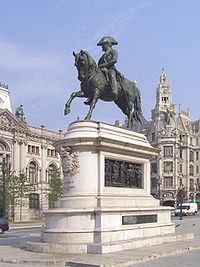 Equestrian statue of Pedro I in Porto
Equestrian statue of Pedro I in Porto Main article: Liberal Wars
Main article: Liberal WarsSailing from the Azores with a fleet of 34 vessels, Pedro entered Porto on 9 July 1832 without a fight.[48] The Miguelist plan was to draw Pedro's forces into the interior, where they could be surrounded.[49] At the battle of Ponte Ferreira, the liberals fought off the Miguelists, and withdrew back into Porto.[50] In the subsequent weeks, the absolutists besieged the city. The siege of Porto lasted for a year; assaults by the Miguelists and attempted break-outs by the liberals were repulsed.[51] Pedro took a risk and in June 1833 sent an expedition by sea to the ill-defended Algarve.[52] This proved a war winning strategy as although the siege of Porto continued it became a secondary theatre of operations. Within a week, the Miguelist fleet was defeated at the battle of Cape Saint Vincent by the British admiral Charles Napier.[53] In July 1833, Pedro arrived in Lisbon. This gave the liberals both of Portugal's major cities, Lisbon and Porto, where they commanded a sizeable following among the middle classes. In contrast, the absolutists controlled the rural areas, where they were supported by the aristocracy, and by a peasantry that was galvanized by the Church. Marshal Saldanha eventually broke the siege of Porto in August 1833, but by the end of the month Lisbon was under siege. Miguelist attacks on 5 and 14 September were repulsed; the liberal lines held.[54] Saldanha broke the siege on 10 October 1833, and forced the Miguelists east toward Santarém. Maria da Glória was proclaimed Queen, with Dom Pedro as Regent. Pedro dismissed Miguelist ministers and clergy and appropriated church property. In early 1834, Saldanha defeated Miguelist forces at the battles of Pernes and Almoster.[55] Liberal forces were victorious at the battle of Asseiceira in May, and entered Santarém on 18 May 1834.[56]
On 22 April 1834 the Quadruple Alliance was drawn up. Portugal, Spain, Britain and France agreed to banish Dom Miguel from Portugal and Don Carlos from Spain. Spain committed to keep troops in Portugal until the end of the Portuguese Liberal Wars, Britain promised naval support for Dom Pedro and Isabella II of Spain, and Portugal agreed to supply an auxiliary force for operations against Don Carlos in Spain. By 27 May 1834, Miguel's officers were unwilling to risk a final battle after nearly two years of warfare, despite still having 18,000 men in the ranks. Miguel was induced to seek terms of capitulation and by the Convention of Évora-Monte renounced all claims to the throne of Portugal and agreed to go into exile.[57] Maria II's betrothal to Miguel was annulled, and she married her stepmother's brother, Auguste de Beauharnais, 2nd Duke of Leuchtenberg.
Pedro had finally put his daughter Maria da Gloria back on the throne but this would be his last act. He died of tuberculosis in Queluz, the palace of his birth, aged 35 at 2:30 p.m. on 24 September 1834.[58] In 1972, his remains were returned to Brazil and re-interred in the present Ipiranga Museum.
Titles and honors
Styles of
Pedro I, Emperor of Brazil
Reference style His Imperial Majesty Spoken style Your Imperial Majesty Alternative style Sire Royal styles of
Pedro IV, King of Portugal
Reference style His Most Faithful Majesty Spoken style Your Most Faithful Majesty Alternative style Sire Titles and styles
- 12 October 1798 – 11 June 1801: His Royal Highness The Most Serene Infante Dom Pedro, Grand Prior of Crato[59]
- 11 June 1801 – 20 March 1816: His Royal Highness The Prince of Beira[59]
- 20 March 1816 – 9 January 1817: His Royal Highness The Prince of Brazil[59]
- 9 January 1817 – 12 October 1822: His Royal Highness The Prince Royal[59]
- 12 October 1822 – 7 April 1831: His Imperial Majesty The Emperor[59]
- 10 March 1826 – 28 May 1826: His Most Faithful Majesty The King[59]
As Brazilian Emperor his full style and title were: "His Imperial Majesty Dom Pedro I, Constitutional Emperor and Perpetual Defender of Brazil".[60] After his abdication the style "His Imperial Majesty the Duke of Braganza" was used.[61]
As Portuguese King his full style and title were: "His Most Faithful Majesty Dom Pedro IV, King of Portugal and the Algarves, of either side of the sea in Africa, Lord of Guinea and of Conquest, Navigation and Commerce of Ethiopia, Arabia, Persia and India, etc."[62]
Nobility
As heir to the Portuguese crown:[63]
- Duke of Braganza[6]
- Duke of Barcelos[6]
- Duke of Guimarães[6]
- Marquis of Vila Viçosa[6]
- Count of Ourém[6]
- Count of Barcelos[6]
- Count of Faria and Neiva[6]
- Count of Arraiolos[6]
- Count of Guimarães[6]
Honors
Emperor Pedro I was Grand Master (Sovereign) of the following Brazilian Orders:
- Order of Christ[64]
- Order of Saint Benedict of Aviz[64]
- Order of Saint James of the Sword[64]
- Order of the Southern Cross[64]
- Order of Pedro I[64]
- Order of the Rose[64]
As King Pedro IV, he was Grand Master (Sovereign) of the following Portuguese Orders:
- Order of Christ[6]
- Order of Saint Benedict of Aviz[6]
- Order of Saint James of the Sword[6]
- Order of the Tower and Sword[6]
- Order of the Immaculate Conception of Vila Viçosa[6]
After having abdicated the Portuguese crown:
- Grand Cross of the Portuguese Order of the Tower and of the Sword, of Valor, Loyalty and Merit on 20 September 1834[59]
He was a recipient of the following foreign honors:
- Knight of the Spanish Order of the Golden Fleece[65]
- Grand Cross of the Spanish Order of Charles III[59]
- Grand Cross of the Spanish Order of Isabella the Catholic[59]
- Grand Cross of the French Order of Saint Louis[59]
- Knight of the French Order of the Holy Spirit[59]
- Knight of the French Order of Saint Michael[59]
- Grand Cross of the Austro-Hungarian Order of Saint Stephen[59]
Genealogy
Ancestry
Ancestors of Pedro I of Brazil 16. Peter II of Portugal 8. John V of Portugal 17. Maria Sofia of the Palatinate 4. Peter III of Portugal 18. Leopold I, Holy Roman Emperor 9. Maria Anna of Austria 19. Eleonor Magdalene of the Palatinate 2. John VI of Portugal 20. John V of Portugal (= 8) 10. Joseph I of Portugal 21. Maria Anna of Austria (= 9) 5. Maria I of Portugal 22. Philip V of Spain 11. Mariana Victoria of Spain 23. Elisabeth Farnese 1. Pedro I of Brazil 24. Philip V of Spain (= 22) 12. Charles III of Spain 25. Elisabeth Farnese (= 23) 6. Charles IV of Spain 26. Augustus III of Poland 13. Maria Amalia of Saxony 27. Maria Josepha of Austria 3. Carlota Joaquina of Spain 28. Philip V of Spain (= 22) 14. Philip, Duke of Parma 29. Elisabeth Farnese (= 23) 7. Maria Luisa of Parma 30. Louis XV of France 15. Princess Louise Élisabeth of France 31. Marie Leszczyńska Issue
By his first wife, Maria Leopoldina, Archduchess of Austria (22 January 1797 – 11 December 1826):
- Maria II of Portugal (4 April 1819 – 15 November 1853)
- Miguel, Prince of Beira (26 April 1820, stillborn)
- João Carlos, Prince of Beira (6 March 1821 – 4 February 1822)
- Januária Maria, Princess Imperial of Brazil (11 March 1822 – 13 March 1901). Married Prince Louis, Count of Aquila, son of Francis I of the Two Sicilies, and had issue.
- Princess Paula of Brazil (17 February 1823 – 16 January 1833).
- Princess Francisca of Brazil (2 August 1824 – 27 March 1898). Married Prince François, Prince of Joinville, son of Louis Philippe I, and had issue.
- Pedro II of Brazil (2 December 1825 – 5 December 1891)
By his second wife, Amélie de Beauharnais, Duchess of Leuchtenberg (31 July 1812 – 26 January 1873):
- Princess Maria Amélia of Brazil (1 December 1831 – 4 February 1853).
His illegitimate children included three by his best known lover, Domitila, Marchioness of Santos:
- Isabel Maria de Alcântara Brasileiro, Duchess of Goiás (born 23 May 1824)[66][67]
- Pedro de Alcântara Brasileiro (born 7 December 1825)[68] He died in infancy.[67]
- Maria Isabel, Duchess of Ceará (born 13 August 1827)[69] She died of meningitis in October 1828.[70]
He had other illegitimate children, including a son Rodrigo (born in November 1823) with Domitila's sister Maria Bendita, baroness of Sorocaba,[71] and a son with Frenchwoman Clémence Saisset.[72] His lovers were reputed to include the wife of French naturalist Aimé Bonpland,[71][72] ballerina Noemí Valençay (also known as Noémi Thierry),[73][74] and the wife of General Jorge de Avilez, commander of the Rio garrison,[72][74] among many others.[72]
See also
Notes
- ^ Lustosa 2006, p. 36.
- ^ Calmon 1950, p. 14.
- ^ Sousa 1972a, pp. 10–11.
- ^ a b Macaulay 1986, p. 6.
- ^ Calmon 1975, p. 3.
- ^ a b c d e f g h i j k l m n o Branco 1838, p. XXXVI.
- ^ Barman 1999, p. 424.
- ^ Calmon 1950, pp. 5, 9.
- ^ Sousa 1972a, p. 10.
- ^ Calmon 1950, p. 11.
- ^ Sousa 1972a, pp. 5, 9.
- ^ Calmon 1950, p. 12.
- ^ Macaulay 1986, p. 3.
- ^ Sousa 1972a, p. 9.
- ^ a b c Macaulay 1986, p. 7.
- ^ a b Sousa 1972a, p. 12.
- ^ Barman 1999, p. 14.
- ^ a b Macaulay 1986, p. 33.
- ^ Barman 1999, p. 41.
- ^ Costa 1972, pp. 12–13.
- ^ a b Costa 1972, p. 29.
- ^ a b Costa 1972, p. 30.
- ^ Costa 1972, p. 34.
- ^ Costa 1972, pp. 33, 35.
- ^ Costa 1972, p. 32.
- ^ Costa 1972, p. 42.
- ^ a b c Costa 1972, p. 45.
- ^ Costa 1972, p. 62.
- ^ Costa 1972, pp. 68–69.
- ^ Costa 1972, p. 69.
- ^ Costa 1972, pp. 70–71.
- ^ Costa 1972, p. 71.
- ^ Costa 1972, pp. 77–78.
- ^ Costa 1972, pp. 83–85.
- ^ Costa 1972, p. 99.
- ^ Costa 1972, p. 100.
- ^ Costa 1972, p. 89.
- ^ Costa 1972, pp. 123–124.
- ^ Costa 1972, p. 125.
- ^ Costa 1972, p. 135.
- ^ Costa 1972, pp. 135–139.
- ^ Costa 1972, pp. 137–141.
- ^ Costa 1972, p. 142.
- ^ a b Costa 1972, p. 171.
- ^ Costa 1972, pp. 163–166.
- ^ Costa 1972, p. 167.
- ^ Costa 1972, p. 168.
- ^ Costa 1972, pp. 177–180.
- ^ Costa 1972, pp. 180–181.
- ^ Costa 1972, pp. 182–184.
- ^ Costa 1972, pp. 187–191.
- ^ Costa 1972, p. 195.
- ^ Costa 1972, pp. 196–198.
- ^ Costa 1972, pp. 203–204.
- ^ Costa 1972, pp. 205–206.
- ^ Costa 1972, p. 206.
- ^ Costa 1972, p. 206–207.
- ^ Costa 1972, p. 211.
- ^ a b c d e f g h i j k l m Branco 1838, p. XXXVII.
- ^ Rodrigues 1863, p. 71.
- ^ Costa 1972, p. 209.
- ^ "Carta Constitucional de 1826" (PDF). http://www.fd.unl.pt/Anexos/Investigacao/1533.pdf. Retrieved 2010-12-02.
- ^ Branco 1838, p. XXIV.
- ^ a b c d e f Barman 1999, p. 11.
- ^ Branco 1838, pp. XXXVI–XXXVII.
- ^ Costa 1972, pp. 104, 107.
- ^ a b Macaulay 1986, p. 196.
- ^ Costa 1972, p. 104.
- ^ Costa 1972, p. 130.
- ^ Macaulay 1986, p. 228.
- ^ a b Macaulay 1986, p. 170.
- ^ a b c d Costa 1972, p. 68.
- ^ Costa 1972, p. 67.
- ^ a b Macaulay 1986, p. 53.
References
- Barman, Roderick J. (1999). Citizen Emperor: Pedro II and the Making of Brazil, 1825–1891. Stanford, California: Stanford University Press. ISBN 0804735107.
- Branco, João Carlos Feo Cardoso de Castello (1838) (in Portuguese). Resenha das familias titulares do reino de Portugal: Acompanhada das notícias biográphicas de alguns indivíduos da mesmas famílias. Lisbon: Imprensa Nacional.
- Calmon, Pedro (1950) (in Portuguese). O Rei Cavaleiro (6 ed.). São Paulo: São Paulo.
- Costa, Sérgio Corrêa da (1972) [1950]. Every Inch a King: A Biography of Dom Pedro I First Emperor of Brazil. Translated by Samuel Putnam. London: Robert Hale. ISBN 0709129742.
- Lustosa, Isabel (2006) (in Portuguese). D. Pedro I: um herói sem nenhum caráter. São Paulo: Companhia das Letras. ISBN 85-359-0807-2.
- Macaulay, Neill (1986). Dom Pedro: The Struggle for Liberty in Brazil and Portugal, 1798–1834. Durham, North Carolina: Duke University Press. ISBN 0-8223-0681-6. http://books.google.ca/books?id=__0KrEZGkmUC&printsec=frontcover&dq=Dom+Pedro&hl=en&ei=ivWmTKe3B8_Hswaj6cyYDA&sa=X&oi=book_result&ct=result&resnum=1&ved=0CCsQ6AEwAA#v=onepage&q&f=false.
- Rodrigues, José Carlos (1863) (in Portuguese). A Constituição política do Império do Brasil. Rio de Janeiro: Typographia Universal de Laemmert.
- Sousa, Otávio Tarquínio de (1972a) (in Portuguese). A vida de D. Pedro I. 1. Rio de Janeiro: José Olympio.
- Sousa, Otávio Tarquínio de (1972b) (in Portuguese). A vida de D. Pedro I. 2. Rio de Janeiro: José Olympio.
- Sousa, Otávio Tarquínio de (1972c) (in Portuguese). A vida de D. Pedro I. 3. Rio de Janeiro: José Olympio.
Further reading
- Harvey, Robert (2000). Liberators: Latin America's Struggle For Independence, 1810–1830. London: John Murray. ISBN 0-7195-5566-3.
Pedro I of BrazilCadet branch of the House of AvizBorn: 12 October 1798 Died: 24 September 1834Regnal titles New title
Acclaimed as Emperor of BrazilEmperor of Brazil
12 October 1822 – 7 April 1831Succeeded by
Pedro IIPreceded by
John VIKing of Portugal and the Algarves
10 March – 28 May 1826Succeeded by
Maria II Empire of Brazil
Empire of BrazilGeneral topics Wars Brazilian Independence (1822–1824) · Cisplatine War (1825–1828) · Platine War (1851–1852) · Uruguayan War (1864–1865) · Paraguayan War (1864–1870)Emperors Pedro I · Pedro IIStatesmen José Bonifácio de Andrada · Marquis of Paraná · Viscount of Rio BrancoMilitary Abolitionists The Brazilian Imperial Family Forefathers John VI of Portugal · Queen Carlota (née Infanta of Spain)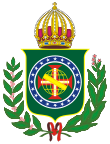
First generation Emperor Pedro I · Empress Leopoldina (née Archduchess of Austria) · Empress Amélie (née Princess of Leuchtenberg)Second generation Emperor Pedro II · Empress Teresa Cristina (née Princess of Bourbon-Two Sicilies) · Maria II of Portugal · Januária, Princess Imperial and Countess of Aquila · Princess Paula · Francisca, Princess of Joinville · Princess MariaThird generation Afonso, Prince Imperial · Pedro, Prince Imperial · Isabel, Princess Imperial · Prince Gaston of Orléans, Count of Eu · Leopoldina, Princess of Saxe-Coburg-KoharyFourth generation Pedro de Alcântara, Prince of Grão-Pará · Prince Luís · Princess Maria Pia (née Princess of Bourbon-Two Sicilies) · Prince Antônio GastãoConsorts are in italicsInfantes of Portugal The generations indicate descent form Afonso I, and continues through the House of Aviz, the House of Bourbon through Isabella of Portugal, and the House of Braganza through Infanta Catherine, Duchess of Braganza.1st Generation 2nd Generation Infante Raimundo • Afonso II • Infante Pedro, Count of Urgell • Infante Fernando, Count of Flanders • Infante Henrique3rd Generation 4th Generation 5th Generation Infante Afonso, Lord of Leiria • Afonso IV6th Generation 7th Generation Infante Luís • Ferdinand I • Infante Afonso • Infante João, Duke of Valencia de Campos • Infante Dinis, Lord of Cifuentes8th Generation Infante Pedro • Infante Afonso • Infante Afonso • Edward I • Infante Pedro, 1st Duke of Coimbra • Infante Henrique, 1st Duke of Viseu • Infante João, Lord of Reguengos de Monsaraz • Infante Fernando, the Saint Prince9th Generation Infante Miguel^ • Infante Diogo, Constable of Portugal • Infante João • Peter V, King of Aragon • Infante João, Prince of Antioch • Afonso V • Cardinal-Infante Jaime • Infante Fernando, 2nd Duke of Viseu • Infante Duarte10th Generation Infante João, 3rd Duke of Viseu • Infante Diogo, 4th Duke of Viseu • João, Prince of Portugal • John II • Infante Duarte • Infante Diniz • Infante Simião • Infante Afonso • Manuel I11th Generation Afonso, Prince of Portugal • Infante João • Miguel da Paz, Prince of Portugal and Asturias^ • John III • Infante Luís, 5th Duke of Beja • Infante Fernando, Duke of Guarda and Trancoso • Cardinal-Infante Afonso • Henry, The Cardinal-King • Infante Duarte, 4th Duke of Guimarães • Infante António • Infante Carlos12th Generation Afonso, Prince of Portugal • Manuel, Prince of Portugal • Filipe, Prince of Portugal • Infante Dinis • John Manuel, Prince of Portugal • Infante António13th Generation 14th Generation 15th Generation Balthasar Charles, Prince of Portugal and Asturias* • Infante Francisco Fernando* • Teodósio, 1st Prince of Brazil • Afonso VI • Peter II16th Generation João, 3rd Prince of Brazil • John V • Infante Francisco, 7th Duke of Beja • Infante António • Infante Manuel, Count of Ourém •17th Generation 18th Generation none19th Generation 20th Generation Francisco António, 8th Prince of Beira • Peter I of Brazil & IV of Portugal • Miguel I • Infante Pedro Carlos* • Infante Carlos José Antonio*21st Generation 22nd Generation Pedro V • Luís I • Infante João, 8th Duke of Beja • Infante Fernando • Infante Augusto, 3rd Duke of Coimbra • Infante Leopoldo • Infante Eugénio Maria • Infante Miguel, 6th Duke of Viseu • Infante Francisco José • Infante Duarte Nuno, 25th Duke of Braganza23rd Generation Carlos I • Afonso, Prince Royal and 3rd Duke of Porto • Infante Duarte Pio, Duke of Braganza • Infante Miguel, Duke of Viseu • Infante Henrique, Duke of Coimbra24th Generation Luís Filipe, Prince Royal • Manuel II • Infante Dinis, Duke of Porto • Infante Afonso, Prince of Beira •^also an infante of Castile and León, Aragon, Sicily and Naples, *also an infante of Spain, **claimant infante, ^^only prince or infante by marriageCategories:- Brazilian monarchs
- Portuguese monarchs
- 1798 births
- 1834 deaths
- 19th-century Brazilian people
- 19th-century Portuguese people
- Brazilian nobility
- Brazilian people of Portuguese descent
- Brazilian people of Spanish descent
- Deaths from tuberculosis
- Dukes of Braganza
- Emperors
- Grand Crosses of the Order of Charles III
- Grand Crosses of the Order of Isabella the Catholic
- Grand Crosses of the Order of the Tower and Sword
- Grand Masters of the Order of Pedro I
- Grand Masters of the Order of the Immaculate Conception of Vila Viçosa
- Grand Masters of the Order of the Southern Cross
- Grand Masters of the Order of the Tower and Sword
- House of Braganza
- Infectious disease deaths in Portugal
- Knights Grand Cross of the Order of Isabella the Catholic
- Knights Grand Cross of the Order of Saint Stephen of Hungary
- Knights of Christ
- Knights of the Golden Fleece
- National anthem writers
- Nobility of the Americas
- Order of Saint Michael
- Order of the Rose
- People of the Cisplatine War
- People of the Latin American wars of independence
- Portuguese infantes
- Portuguese royalty
- Princes of Beira
- Princes Royal of Portugal
- Recipients of the Order of Aviz
- Recipients of the Order of Christ (Brazil)
- Recipients of the Order of Saint James of the Sword
- Recipients of the Order of the Holy Spirit
- Regents of Brazil
- Roman Catholic monarchs
Wikimedia Foundation. 2010.

